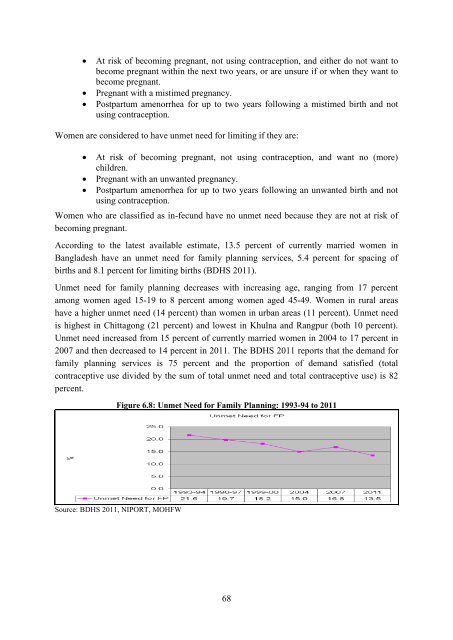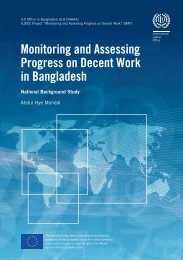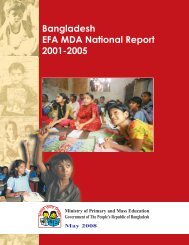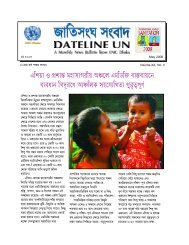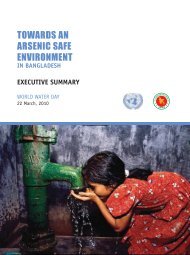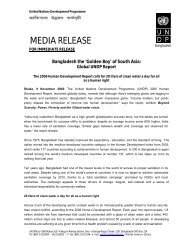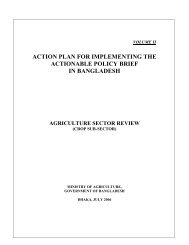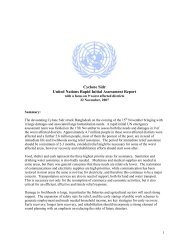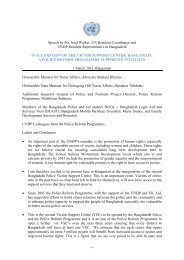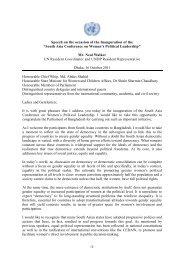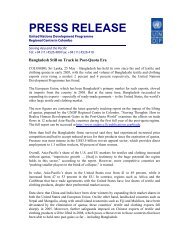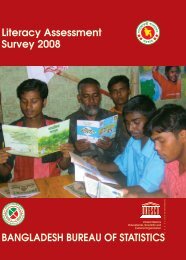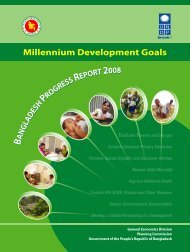MDG Report 2012 - United Nations in Bangladesh
MDG Report 2012 - United Nations in Bangladesh
MDG Report 2012 - United Nations in Bangladesh
- No tags were found...
Create successful ePaper yourself
Turn your PDF publications into a flip-book with our unique Google optimized e-Paper software.
At risk of becom<strong>in</strong>g pregnant, not us<strong>in</strong>g contraception, and either do not want tobecome pregnant with<strong>in</strong> the next two years, or are unsure if or when they want tobecome pregnant.Pregnant with a mistimed pregnancy.Postpartum amenorrhea for up to two years follow<strong>in</strong>g a mistimed birth and notus<strong>in</strong>g contraception.Women are considered to have unmet need for limit<strong>in</strong>g if they are:At risk of becom<strong>in</strong>g pregnant, not us<strong>in</strong>g contraception, and want no (more)children.Pregnant with an unwanted pregnancy.Postpartum amenorrhea for up to two years follow<strong>in</strong>g an unwanted birth and notus<strong>in</strong>g contraception.Women who are classified as <strong>in</strong>-fecund have no unmet need because they are not at risk ofbecom<strong>in</strong>g pregnant.Accord<strong>in</strong>g to the latest available estimate, 13.5 percent of currently married women <strong>in</strong><strong>Bangladesh</strong> have an unmet need for family plann<strong>in</strong>g services, 5.4 percent for spac<strong>in</strong>g ofbirths and 8.1 percent for limit<strong>in</strong>g births (BDHS 2011).Unmet need for family plann<strong>in</strong>g decreases with <strong>in</strong>creas<strong>in</strong>g age, rang<strong>in</strong>g from 17 percentamong women aged 15-19 to 8 percent among women aged 45-49. Women <strong>in</strong> rural areashave a higher unmet need (14 percent) than women <strong>in</strong> urban areas (11 percent). Unmet needis highest <strong>in</strong> Chittagong (21 percent) and lowest <strong>in</strong> Khulna and Rangpur (both 10 percent).Unmet need <strong>in</strong>creased from 15 percent of currently married women <strong>in</strong> 2004 to 17 percent <strong>in</strong>2007 and then decreased to 14 percent <strong>in</strong> 2011. The BDHS 2011 reports that the demand forfamily plann<strong>in</strong>g services is 75 percent and the proportion of demand satisfied (totalcontraceptive use divided by the sum of total unmet need and total contraceptive use) is 82percent.Figure 6.8: Unmet Need for Family Plann<strong>in</strong>g: 1993-94 to 2011Source: BDHS 2011, NIPORT, MOHFW68


